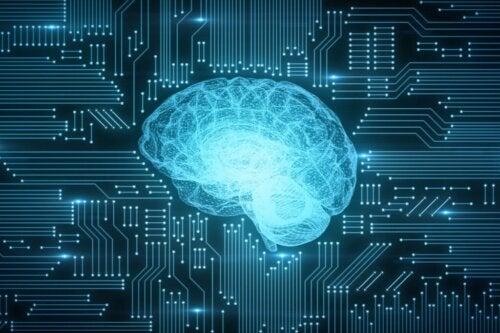One of the biggest mysteries that philosophy, psychology, and neuroscience are trying to solve is how the human mind works. The philosopher John Locke once said that a baby’s mind is like a blank slate. Sigmund Freud compared this entity to an invisible mechanism of hydraulic and electromagnetic systems.
Today, cognitive psychologists like Steven Pinker tell us that the mind is a neural computer. Conceiving this idea allows us to separate it from the brain and see it as an entity that makes information flow and defines, in turn, the person you are. We could say that it’s the “energy” we get from the brain itself, the body, and the environment in order to draw conclusions and survive.
We’re talking about a topic that’s as interesting as it is complex and that’s well worth delving into. In this article, you’ll find all the information you need on the subject.
“The mind is like an iceberg. It floats with one-seventh of its bulk above water.”
– Sigmund Freud –
The mind and the brain aren’t the same thing
The mind is the entity that carries out all our psychological processes. In it flow complex and wonderful motivational, emotional, behavioral, and perceptual systems, to name a few, which are necessary for us to be able to act, learn, and understand what surrounds us.
Now, it’s important to clarify that the mind and brain aren’t the same entity. However, the first wouldn’t be able to exist without the second.
The mind emerges the moment a brain reaches sufficient biological sophistication. As a work published in Perspectives on Psychological Science explains, the very future of psychology needs this vision, in which the mind and the brain are understood as connected, but the mind carries out its own functions. What are the subtle differences?
- The mind is an abstract entity that involves consciousness and an infinite number of cognitive processes.
- The brain is its biological support, the area of the central nervous system that’s the result of our evolution.
- The mind isn’t in a physical and concrete place but is manifested through neurological networks and develops through our experience and interrelation with the context that surrounds us.
- The brain can develop disease and suffer trauma; disturbances of the mind can’t be observed. This explains why we label them as “mental disorders,” and psychology is the field that addresses these conditions.
- The mind modifies the brain. What we think and feel can alter the anatomy and connectivity of the brain. Psychotherapy itself is an example of this. As an article in the Indian Journal of Psychiatry states, therapeutic processes have the ability to modify our neurological universe, and this is common when dealing with traumas.
Read also: The Plastic Mind: Awakening Your Transformative Power
Your conscious mind and your unconscious mind: Two modes of operation
If you’ve ever wondered how the human mind works, you’ll be interested to know that it does so basically in two ways: Consciously and unconsciously. And it’s the unconscious mind that’s the most fascinating, as much of what you do every day is automatically carried out by it.
The Journal of the Association for Psychological Science points out that this may surprise you a bit, as we still carry some biases about this psychological construct. Thinking of the term “unconscious” almost instantly brings the theories of Sigmund Freud to mind.
The truth is that this mental layer brings together all those automatic tasks that we carry out frequently and that don’t require active and conscious information processing. What’s more, Neuroscience of Consciousness points out that we even incorporate very simple learning thanks to this mechanism. The following are the distinctions between your conscious and unconscious mind:
Functions of the conscious mind:
- Self-awareness
- Working memory
- Impulse control
- Decision-making
- Emotional self-control
- Imagination and creativity
- Problem resolution
- Logical reasoning and reflection
Intuition is a process that our unconscious mind carries out by storing all our experiences. Thanks to it, we make quick decisions at certain times.
Functions of the unconscious mind
- Intuition.
- Memory storage.
- Some learning, such as that which is based on the association of stimuli.
- Automatic processing of information, such as facial and pattern recognition, as well as received stimuli.
- Habit processing and motor skills. An example of this is learning to write or riding a bicycle. Once we practice enough, these activities are carried out automatically and unconsciously.
Discover also: 1899: A Journey into the Depths of the Human Mind
Theories about how the human mind works
Science still doesn’t know exactly how the human mind works. We continue to debate this issue with a great diversity of approaches and perspectives, and experts fail to come to a clear and rigorous consensus. For example, we can recall what happened regarding the book How the Mind Works by Stephen Pinker.
The theses of this experimental psychologist, a cognitive scientist, raised the commotion of many professional colleagues. There’s no unanimity when conceiving what the mind is or how it works. Therefore, to have a more or less general idea of the subject, we’ll take a look at the different theories that surround it.
The computational theory
The computational model of the mind started from the theory of Noam Chomsky and his generative grammar. According to this renowned linguist, there are innate rules that explain the ease with which we all learn language from a young age. Those rules would start from our natural and automatic ability to recognize symbols.
In this dimension, the mind isn’t seen as a computer but as a system that manipulates complex symbols. In fact, it’s comparable to the machine that Alan Turing built at the time.
- A computation is a set of rules that articulate and process each stimulus we receive, giving it meaning.
- For this model, the way the human mind works is similar to a device that constantly creates symbols. Thanks to them, we understand the world and move through it.
The information processing theory and how the mind works
Information processing theory describes the human mind as a computer in which all information is recorded, encoded, and stored. Books such as Human Information Processing (1972) by Peter H. Lindsay and Donald A. Norman laid the foundations of cognitive psychology by seeing humans as beings that are basically limited to processing information.
- According to this theory, the mind is the software, and the brain is the hardware.
- According to this perspective, the most decisive phase is contained between the moment we receive a stimulus and the moment we issue a response. The way in which we elaborate and handle each piece of information, sensation, or experience is decisive.
The modular theory of mind
One more hypothesis about how the human mind works is that which Steven Pinker exposed in his book and which has a long tradition in psychology. According to the modular theory, the mind is organized into modules, in different specialized structures.
This model draws on evolutionary psychology and says that, like our body, the mind is the result of evolution. Over time, we integrate new collections of mental domains and abilities to better adapt to the environment.
What we think determines what happens to us. Therefore, if we want to change our lives, we need to stretch our minds.
– Wayne Dyer –
We know more about how the mind works, but there’s still more to discover
Although scientific research has shed light on many mysteries of the brain and mind, what remains to be known exceeds the answers available to us. The mental universe lacks matter. It’s not a network of neurons inside a cranial cavity. It’s a dimension that’s formless yet so powerful that it defines who we are and the way we process reality.
It’s very possible that more data will be clarified in the coming years, and the community of experts will find greater harmony and offer us more precise explanations.
The post How Does the Human Mind Work? appeared first on Exploring your mind.












Comments